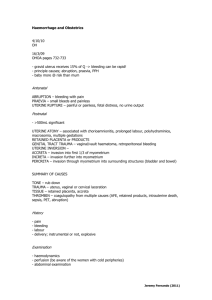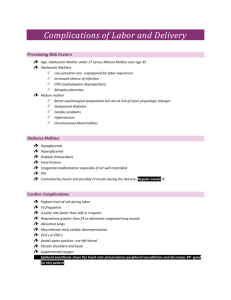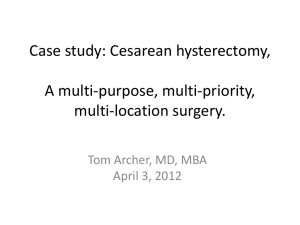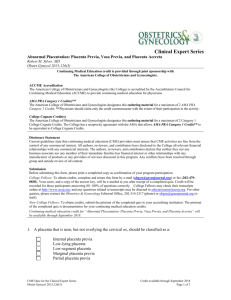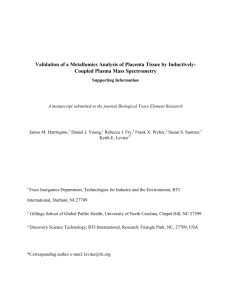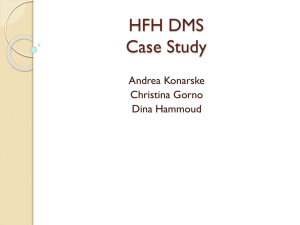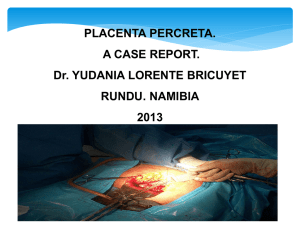Management of Placenta Accreta
advertisement
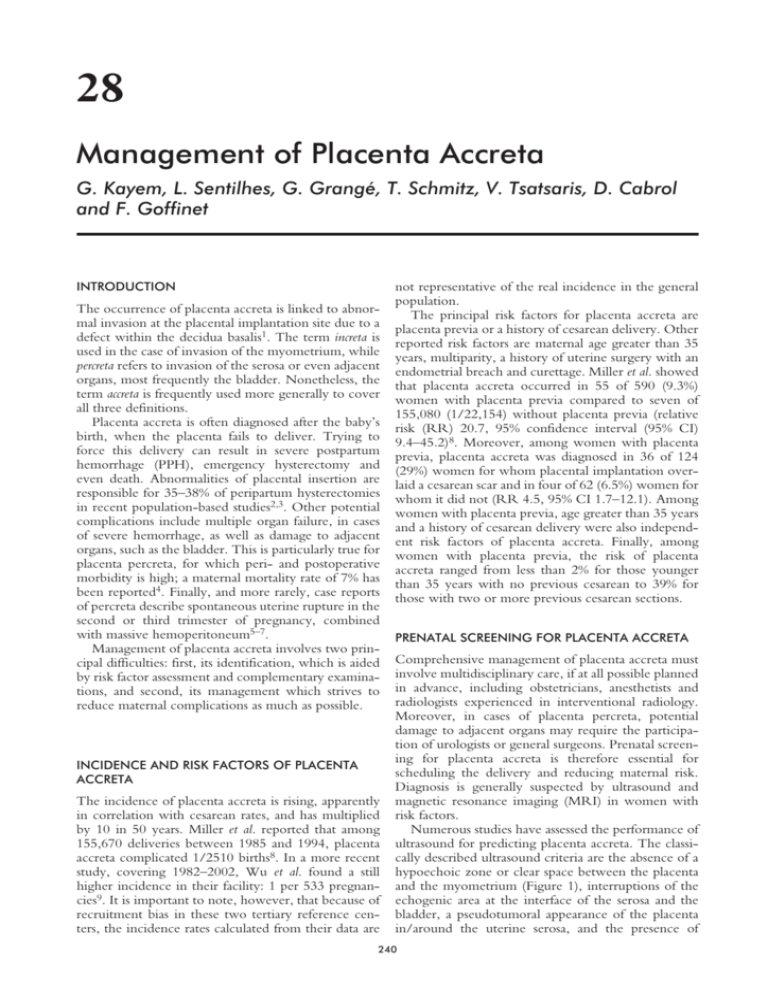
28 Management of Placenta Accreta G. Kayem, L. Sentilhes, G. Grangé, T. Schmitz, V. Tsatsaris, D. Cabrol and F. Goffinet INTRODUCTION The occurrence of placenta accreta is linked to abnormal invasion at the placental implantation site due to a defect within the decidua basalis1. The term increta is used in the case of invasion of the myometrium, while percreta refers to invasion of the serosa or even adjacent organs, most frequently the bladder. Nonetheless, the term accreta is frequently used more generally to cover all three definitions. Placenta accreta is often diagnosed after the baby’s birth, when the placenta fails to deliver. Trying to force this delivery can result in severe postpartum hemorrhage (PPH), emergency hysterectomy and even death. Abnormalities of placental insertion are responsible for 35–38% of peripartum hysterectomies in recent population-based studies2,3. Other potential complications include multiple organ failure, in cases of severe hemorrhage, as well as damage to adjacent organs, such as the bladder. This is particularly true for placenta percreta, for which peri- and postoperative morbidity is high; a maternal mortality rate of 7% has been reported4. Finally, and more rarely, case reports of percreta describe spontaneous uterine rupture in the second or third trimester of pregnancy, combined with massive hemoperitoneum5–7. Management of placenta accreta involves two principal difficulties: first, its identification, which is aided by risk factor assessment and complementary examinations, and second, its management which strives to reduce maternal complications as much as possible. INCIDENCE AND RISK FACTORS OF PLACENTA ACCRETA The incidence of placenta accreta is rising, apparently in correlation with cesarean rates, and has multiplied by 10 in 50 years. Miller et al. reported that among 155,670 deliveries between 1985 and 1994, placenta accreta complicated 1/2510 births8. In a more recent study, covering 1982–2002, Wu et al. found a still higher incidence in their facility: 1 per 533 pregnancies9. It is important to note, however, that because of recruitment bias in these two tertiary reference centers, the incidence rates calculated from their data are not representative of the real incidence in the general population. The principal risk factors for placenta accreta are placenta previa or a history of cesarean delivery. Other reported risk factors are maternal age greater than 35 years, multiparity, a history of uterine surgery with an endometrial breach and curettage. Miller et al. showed that placenta accreta occurred in 55 of 590 (9.3%) women with placenta previa compared to seven of 155,080 (1/22,154) without placenta previa (relative risk (RR) 20.7, 95% confidence interval (95% CI) 9.4–45.2)8. Moreover, among women with placenta previa, placenta accreta was diagnosed in 36 of 124 (29%) women for whom placental implantation overlaid a cesarean scar and in four of 62 (6.5%) women for whom it did not (RR 4.5, 95% CI 1.7–12.1). Among women with placenta previa, age greater than 35 years and a history of cesarean delivery were also independent risk factors of placenta accreta. Finally, among women with placenta previa, the risk of placenta accreta ranged from less than 2% for those younger than 35 years with no previous cesarean to 39% for those with two or more previous cesarean sections. PRENATAL SCREENING FOR PLACENTA ACCRETA Comprehensive management of placenta accreta must involve multidisciplinary care, if at all possible planned in advance, including obstetricians, anesthetists and radiologists experienced in interventional radiology. Moreover, in cases of placenta percreta, potential damage to adjacent organs may require the participation of urologists or general surgeons. Prenatal screening for placenta accreta is therefore essential for scheduling the delivery and reducing maternal risk. Diagnosis is generally suspected by ultrasound and magnetic resonance imaging (MRI) in women with risk factors. Numerous studies have assessed the performance of ultrasound for predicting placenta accreta. The classically described ultrasound criteria are the absence of a hypoechoic zone or clear space between the placenta and the myometrium (Figure 1), interruptions of the echogenic area at the interface of the serosa and the bladder, a pseudotumoral appearance of the placenta in/around the uterine serosa, and the presence of 240 Management of Placenta Accreta Figure 1 A classic ultrasound characteristic predicting placenta accreta is absence of clear space between the placenta and the myometrium Figure 2 Intraplacental lacunae (grade 3) giving placenta a ‘moth-eaten’ appearance intraplacental lacunae in the accreta zone, which give the placenta a ‘swiss cheese’ or ‘moth-eaten’ appearance (Figure 2). Guy et al. reported that the use of these criteria had a positive predictive value (PPV) of 62% for placenta accreta10. Similarly, Finberg and Williams obtained a PPV of 78% and a negative predictive value (NPV) of 93% with the use of ultrasound11. Ultrasound signs can appear quite early. Comstock et al. showed that at 15–20 weeks, the presence of intraplacental lacunae was the best predictive marker of placenta accreta, with a sensitivity of 79% and a PPV of 92%12. The absence of a retroplacental hypoechoic clear space, although considered to be a good predictive sign of placenta accreta, had a sensitivity of only 57% with 48% false positives. After 20 weeks, the sensitivity of these diagnostic criteria increased, reaching 93% for the lacunae and 80% for the absence of the retroplacental clear space. Finally, an ultrasound appearance of a convex or ‘tented’ bladder was associated with placenta accreta, even in the absence of increta or percreta implantation. It was not specific for bladder invasion12. Yang et al. studied the predictive value of placental lacunae for maternal morbidity in 51 patients with placenta previa and a history of cesarean delivery13. These authors classified the intraplacental lacunae according to a score based on Finberg’s criteria11: the absence of lacuna was classified as grade zero, one to three small lacunae as grade 1, four to six large, irregular lacunae as grade 2, and numerous lacuna including some that were large and irregular as grade 3. Grade 1 lacunae had the best predictive value, with a sensitivity of 86%, a specificity of 78%, PPV of 76% and NPV of 88%. No hysterectomy was performed in women without lacunae. Three-dimensional power ultrasound, with Doppler energy data acquisition, has also been tested in a prospective study including 170 women with placenta previa, 39 of whom also had accreta14. Both twoand three-dimensional Doppler criteria were analysed. The three-dimensional criteria were: (1) confluent vessels at the junction between the bladder and uterine serosa; (2) hypervascularization on lateral view; and (3) inseparable cotyledonal and intervillous circulations, with a chaotic appearance. These three-dimensional power Doppler signs had excellent diagnostic value, with a sensitivity of 100% and a specificity of 85% when at least one of the three was present. The best sign was that of vascular confluence at the basal plate, which had a sensitivity of 97% and a specificity of 92%. The diagnostic value of both standard two-dimensional gray scale and Doppler color signs in this study was of a lesser magnitude. In particular, the presence of placental lacunae had a sensitivity of 54% and a specificity of 85%. Finally, MRI is useful for this diagnosis15,16, especially for a posterior placenta17. Among the diagnostic criteria proposed are abnormal bulging of the lower segment, heterogeneity of signal intensity in T2weighted (T2) imaging, and dark intraplacental bands, also in T2 imaging18. The most interesting study, because it came closest to daily clinical practice, is that reported by Warshak et al.19. All the women who had a history of uterine scar (or myomectomy) and either placenta previa or a low-lying placenta had an initial Doppler ultrasound. If placenta accreta was suspected (uterine scar and placental implantation near the scar), MRI was performed with gadolinium injection. Placentation was then considered abnormal if manual removal of the placenta was difficult (due to its adhesion to the myometrium) and it resulted in PPH (clinical diagnosis), or if the pathology examination found villi but no decidual cells in the myometrium (pathology diagnosis). Of the 453 patients studied, 9% had placenta accreta. MRI allowed a diagnosis of placenta accreta to be ruled out in 14 of the 16 Doppler ultrasound false-positive results. Performing MRI when ultrasound findings suggest placenta accreta thus seems useful for improving the performance of Doppler ultrasound. Gadolinium appears to improve the specificity of MRI in marking the border between the placenta and the myometrium more clearly. The safety of gadolinium has not been demonstrated in the fetus, 241 POSTPARTUM HEMORRHAGE but its use is authorized by the European Society of Urogenital Radiology when required and without any specific follow-up. MANAGEMENT OF PLACENTA ACCRETA SUSPECTED BEFORE DELIVERY A consensus approach to placenta accreta is to leave it in situ20,21, as trying to detach it can induce a massive hemorrhage22. Two types of management are possible: a cesarean hysterectomy or conservative treatment, consisting in leaving the placenta in the uterine cavity without hysterectomy. In both instances, however, the difficulty is that there is no diagnostic technique that provides a PPV of 100% for the diagnosis of placenta accreta. CESAREAN HYSTERECTOMY For women who do not desire further children, a hysterectomy following the cesarean is appropriate if the risk factors and imaging strongly indicate the diagnosis. In this case, the placenta is left in place after removal of the newborn by a hysterotomy incision, preferably at a distance from the placental bed. A prudent attempt at placental delivery includes the injection of 5 IU of oxytocin and moderate cord traction to confirm the diagnosis; this strategy seems reasonable in view of the possibility of false-positive images, although it does include the risk of inducing bleeding. If this effort fails, an experienced team performs a hysterectomy. During this procedure, which must be planned, blood loss is assessed and units of packed red blood cells and ideally fresh frozen plasma are available should a hemorrhage or disseminated intravascular coagulation develop (see Chapter 5). Some teams recommend the use of a ‘cell saver’ to compensate for blood loss22 (see Chapter 70). The American College of Obstetrics and Gynecology (ACOG) currently recommends a cesarean hysterectomy without attempting manual removal of the placenta when prenatal suspicion of placenta accreta is strong23. Very few series have assessed maternal morbidity after cesarean hysterectomy. In a series of 76 such procedures for placenta accreta, Eller et al. found the following outcomes: transfusion (≥4 units of packed red blood cells) 42%, ureteral injuries 7%, cystotomy 29% and infectious complications 33%24. Another single-center study of cesarean hysterectomies due to placenta accreta in one California hospital25 reported a similar morbidity rate in a comparison of 62 cesarean hysterectomies diagnosed prenatally with 37 cases discovered per partum. These authors showed that the risk of hemorrhage was lower when the diagnosis preceded the cesarean, but 52% of the patients with predelivery diagnoses had placenta accreta; among those without prenatal diagnoses, the rate of bladder injury was 23% and that of ureteral injury 8%. Among the strategies proposed for planned cesarean hysterectomies is intraoperative embolization as soon as the fetus is removed or the preoperative placement of intravascular balloons that can be inflated during the surgery. Uterine artery embolization performed after fetal extraction and before hysterectomy has also been proposed. In a series of 26 women who had a preventive arterial embolization before the hysterectomy, Angtsmann et al. observed significant reductions in blood loss, percentage of patients receiving transfusions and number of units of packed red blood cells transfused26. Placement of intravascular balloons has also been studied. A series of 11 women found encouraging results with reduced bleeding27, while others reported no significant benefits from this procedure28,29. In a retrospective study, Bodner et al. examined29 consecutive patients treated for placenta accreta, divided into two groups: those with (n = 6) and without temporary balloon occlusion (n = 22)29. In this study, temporary occlusion or embolization before hysterectomy failed to reduce the risk of hemorrhage. Similarly, Shrivastava et al. found no beneficial results for 69 women managed for placenta accreta by cesarean hysterectomy28. Nonetheless, this type of study is difficult to perform, especially because of inclusion bias, which can result in including the most serious cases in the group with balloon treatment. For this reason, and because the possibility of controlling hemorrhage by the endovascular pathway during surgery is so seductive for the physician, this technique is still under evaluation, but should generally be reserved for the most complex cases (see Chapter 49). MANAGEMENT OF PLACENTA ACCRETA WITHOUT HYSTERECTOMY Hysterectomy results in permanent sterility, something often not at all desired by the younger parturient, especially if her family is not complete. Moreover, in the context of placenta accreta/percreta, hysterectomy can be accompanied by high morbidity and be lifethreatening. To try to minimize these complications, particularly when the patient expresses a desire for more children, a conservative alternative to extirpative treatment or cesarean hysterectomy has been offered in some institutions20,30. Conservative treatment that leaves the placenta in the uterine cavity The management strategies are outlined below and shown in the algorithm of Figure 3. When placenta accreta is strongly suspected before delivery, based on risk factors and imaging studies that support this diagnosis, management should include the following: (1) The exact position of the placenta is determined by preoperative ultrasound. Cesarean delivery is scheduled. (2) The operation begins with a midline cutaneous incision, enlarged above the umbilicus if necessary. 242 Management of Placenta Accreta (3) The uterine approach uses a midline incision at a distance from the placental bed. After removal of the child, the obstetrician carefully attempts to remove the placenta; failure to do so confirms the diagnosis. In this case, the cord is cut at the site of insertion and the uterine cavity is closed (Figure 4). (4) Postoperative antibiotic therapy (amoxicillin and clavulanic acid) is usually administered prophylactically for 10 days to minimize the risk of infection. Prenatal suspicion of placenta accreta (placenta previa + previous cesarean) + ultrasound +/- MRI Discussion with the patient Staff meeting no Maternal desire for continued fertility Cesarean and hysterectomy in the case of intraoperative confirmation of diagnosis Cesarean: Specific placenta location by ultrasound Vertical uterine incision at a distance from the placenta Fetal extraction Careful attempt at placental delivery with injection of 5 IU of oxytocin and moderate cord traction Success: placenta normally inserted Failure: confirms the diagnosis of placenta accreta Umbilical cord cut Uterine cavity closed - Sulprostone (8.3 ml/h) - At any amount of bleeding, even very minor, embolization of uterine arteries Weekly follow-up until complete resorption of placenta: - Clinical examination (bleeding, temperature, pelvic pain) - Hemoglobin, leukocytes, C reactive protein, vaginal sample for bacteriological analysis. - Ultrasound (size of retained tissue) Figure 3 Algorithm for proposed management strategy of prenatal diagnosis of placenta accreta If the diagnosis is not suspected until the third stage of labor: (1) Manual uterine examination is gentle and unforced. (2) The adherent placenta is left in place partially or completely, especially if the patient’s hemodynamic status is stable and there are no clinical or laboratory signs of infections. (3) Subsequent follow-up requires weekly visits until complete resorption of the placenta. The visits include a clinical examination, pelvic ultrasound and laboratory tests for infection (vaginal sample and C reactive protein). One study from our group compared an extirpative strategy with conservative treatment performed consecutively during two different periods31,32. Conservative treatment was associated with a reduced risk of hemorrhage and a lower hysterectomy rate than extirpative management, but with a higher risk of maternal infection (Table 1). Case reports also describe similar conservative management and underline in particular the risk of complications from hemorrhage and infection33. Two French series have described women with placenta accreta managed conservatively. Bretelle et al. used conservative management for 26 women, but had a final hysterectomy rate of 19%34. Sentilhes et al. report morbidity in 167 cases of placenta accreta treated conservatively at 40 university hospital centers throughout France (Table 2). Severe maternal morbidity occurred in 6% of these cases and the final hysterectomy rate was 22%. One maternal death occurred in a woman with aplastic anemia, nephrotoxicity and septic shock (peritonitis) 3 months after a methotrexate injection in the umbilical cord. After a median delay of 13.5 weeks (4–60 weeks), an empty uterus was obtained spontaneously in 75% of the women, while hysteroscopic resection or curettage was required to obtain an empty Table 1 Comparison of maternal morbidity between extirpative management and conservative management. From Kayem et al.32, with permission Extirpative management (n = 13) Figure 4 Conservative management at the end of intervention. The baby has been delivered by a fundal hysterotomy and the uterus has been closed. The placenta has been left in place and is still visible through the lower segment of the uterus Hysterectomies, n (%) Transfusion Patients (n (%)) Packed red blood cells, ml (mean ± SD) Fresh frozen plasma, ml (mean ± SD) Disseminated intravascular coagulation Transfer to ICU, n (%) Time spent in ICU, days (mean ± SD) Postpartum endometritis, n (%) ICU, intensive care unit 243 11 (84.6) 12 (92.3) Conservative management (n = 38) p-Value 10 (26.3) 25 (65.8) <0.001 <0.13 3230 ± 2170 1081 ± 1357 <0.001 2238 ± 1415 5 (38.5) 7 (53.8) 2.42 ± 2.6 0 197 ± 632 <0.001 1 (2.6) <0.003 11 (28.9) 2.27 ± 0.9 <0.19 <0.85 7 (18.4) <0.22 POSTPARTUM HEMORRHAGE Table 2 Maternal morbidity after conservative treatment for placenta accreta. Data shown as n (%), mean ± standard deviation or median (interquartiles). Some patients had several types of maternal morbidity. From Sentilhes et al.21, with permission Immediate maternal morbidity Emergency hysterectomy Postpartum antibiotic treatment >5 days Patients receiving transfusions Units of packed red cells or fresh frozen plasma >5 Transfer to intensive care Time spent in intensive care (days) Acute pulmonary edema Acute kidney failure Lesion of adjacent organ Septic shock Sepsis Infection Endometritis Infection of uterine wall Peritonitis Pyelonephritis Vesicouterine fistula Uterine necrosis Isolated postpartum fever >38.5°C for 24 hours Thromboembolic complications Secondary third-stage hemorrhage stopped after Uterotonics Manual uterine examination Hysteroscopy and curettage Embolization Delayed hysterectomy Delayed hysterectomy Mean time since birth Indication for delayed hysterectomy Secondary third-stage hemorrhage Sepsis Secondary third-stage hemorrhage and sepsis Vesicouterine fistula Uterine necrosis and sepsis Arteriovenous malformation Maternal request Death Uterine preservation Severe maternal morbidity Placenta accreta (n = 167) 18 (10.8%) 54 (32.3%) 70 (41.9%) 25 (15.0%) 43 (25.7%) 2.36 ± 1.93 1 (0.6%) 1 (0.6%) 1 (0.6%) 1 (0.6%) 7 (4.2%) 47 (28.1%) 15 (9.0%) 8 (4.7%) 2 (1.2%) 2 (1.2%) 1 (0.6%) 2 (1.2%) 17 (10.2%) 3 (1.8%) 18 (10.8%) 2/18 (11.1%)2/ 2/18 (11.1%)2/ 2/18 (11.1%)2/ 4/18 (22.2%)2/ 8/18 (50.0%)2/ 18 (44.8%) 22 (9–45)5 8/18 (44.4%)2/ 2/18 (11.1%)2/ 3/18 (16.7%)2/ 1/18 (5.6%)2/ 2/18 (11.1%)2/ 1/18 (5.6%)2/ 1/18 (5.6%)2/ 1 (0.6%) 131 (78.4%) 10 (6.0%)2 uterus in 25% of the cases, with a median delay of 20 weeks (2–45 weeks)21. Finally and most importantly, the fertility and obstetric outcome of patients treated conservatively for placenta accreta were not impaired, although the risk of placenta accreta in the next pregnancy appears high (30%)35. Conservative treatment with resection of the placental bed Palacios-Jaraquemada et al. have proposed a different approach to conservative treatment36, suggesting resection of the entire placental bed after detaching and pushing the bladder in a caudad direction. Hemorrhage was prevented by suturing the uterine arteries. After resection of the placenta and adjoining uterine wall, the uterine edges are brought together and sutured with U stitches. Uterine compression sutures, somewhat more penetrating than B-Lynch sutures, are used to control possible bleeding37,38. Finally, a resorbable vicryl mesh (polyglycolic acid) is placed above the uterine scar and coated with a non-adhesive cellulose layer. This series included 68 cases of placenta percreta resulting in 18 hysterectomies. The complications observed included two ureteral injuries as well as complications due to both hemorrhage and infection. A somewhat different case of resection of the placenta and lower segment was also published by our group. It involved placenta percreta of a cervicoisthmic pregnancy for which more standard conservative treatment was impossible39. The woman had a subsequent pregnancy without postpartum complications. Adjuvant treatment with conservative management Methotrexate, uterine artery embolization and sulprostone are the three adjuvant treatments described for attempting to manage placenta accreta conservatively40–44. The impact of methotrexate on placental resorption has not been fully assessed. Overall, placental resorption in the reported cases has been variable, ranging from expulsion of the placenta on the 7th day to progressive resorption over a period of 6 months40–42,44. No comparative series have studied methotrexate use for this purpose. Moreover, the slow rate of placental cell renewal at term, compared with at the beginning of pregnancy, suggests that methotrexate might be far less effective than in ectopic pregnancies. For these reasons, no convincing evidence favors the use of methotrexate. Finally, the only maternal death in the study of Sentilhes et al. was due in part to aplastic anemia associated with administration of methotrexate21. Similarly, few studies report placental outcome after uterine artery embolization45,46. The objective is to prevent a secondary hemorrhage, to reduce the risk of blood loss and to accelerate the disappearance of the placenta by necrosis. Nonetheless, arterial embolization is not an innocuous procedure, and complications have been described, in particular, cases of uterine necrosis, ischemia of the lumbar plexus, hemoperitoneum due to dissection of an epigastric artery and ischemia of the lower limbs due to embolism3,21,47–50. MANAGEMENT OF PLACENTA ACCRETA DIAGNOSED AFTER DELIVERY In numerous cases, the diagnosis of accreta is made only in the third stage of labor. This can occur during delivery, when the placenta is not delivered, and no plane of cleavage can be found between the uterus and the placenta. If this attempt was careful, without force or insistence, and the patient’s hemodynamic status is stable, conservative treatment can be attempted. In other cases, the situation requires management of a severe PPH, except that the uterotonics used alone are less effective than in the case, for example, of uterine atony. 244 Management of Placenta Accreta Accordingly, uterine artery embolization or ligation of the hypogastric arteries can be used51,52. Other techniques that have been described include an emergency uterine ligation for hemostasis52,53, placement of an intrauterine balloon to ensure hemostatic compression, argon laser coagulation or even aortic compression54–56. Numerous techniques for uterine compression by B-Lynch or similar sutures, including Haymann’s modification, have been suggested but have not been specifically evaluated for this indication53,57–63. Finally, the failure of these measures or an initial massive hemorrhage requires an emergency hysterectomy. Any delay increases the risk of maternal complications which are discussed more fully in other chapters of this book. CONCLUSION The standard guidelines for placenta accreta are to avoid forcing placental delivery and to perform a hysterectomy. A more conservative approach that leaves the placenta in place can nonetheless be proposed in specific cases where the woman wants to preserve her ability to have children. This strategy must nonetheless be used carefully and in an appropriately equipped facility because of the possible risk of severe maternal morbidity associated with it. References 1. Khong TY, Robertson WB. Placenta creta and placenta praevia creta. Placenta 1987;8:399–409 2. Knight M. Peripartum hysterectomy in the UK: management and outcomes of the associated haemorrhage. BJOG 2007; 114:1380–7 3. Zwart JJ, Richters JM, Ory F, de Vries JI, Bloemenkamp KW, van Roosmalen J. Uterine rupture in The Netherlands: a nationwide population-based cohort study. BJOG 2009; 116:1069–78, discussion 78–80 4. O’Brien JM, Barton JR, Donaldson ES. The management of placenta percreta: conservative and operative strategies. Am J Obstet Gynecol 1996;175:1632–8 5. Baruah S, Gangopadhyay P, Labib MM. Spontaneous rupture of unscarred uterus at early mid-trimester due to placenta percreta. J Obstet Gynaecol 2004;24:705 6. Hlibczuk V. Spontaneous uterine rupture as an unusual cause of abdominal pain in the early second trimester of pregnancy. J Emergency Med 2004;27:143–5 7. Topuz S. Spontaneous uterine rupture at an unusual site due to placenta percreta in a 21-week twin pregnancy with previous cesarean section. Clin Exp Obstet Gynecol 2004;31: 239–41 8. Miller DA, Chollet JA, Goodwin TM. Clinical risk factors for placenta previa-placenta accreta. Am J Obstet Gynecol 1997; 177:210–4 9. Wu S, Kocherginsky M, Hibbard JU. Abnormal placentation: twenty-year analysis. Am J Obstet Gynecol 2005;192: 1458–61 10. Guy GP, Peisner DB, Timor-Tritsch IE. Ultrasonographic evaluation of uteroplacental blood flow patterns of abnormally located and adherent placentas. Am J Obstet Gynecol 1990;163:723–7 11. Finberg HJ, Williams JW. Placenta accreta: prospective sonographic diagnosis in patients with placenta previa and prior cesarean section. J Ultrasound Med 1992;11:333–43 12. Comstock CH, Love JJ Jr., Bronsteen RA, et al. Sonographic detection of placenta accreta in the second and third trimesters of pregnancy. Am J Obstet Gynecol 2004;190:1135–40 13. Yang JI, Lim YK, Kim HS, Chang KH, Lee JP, Ryu HS. Sonographic findings of placental lacunae and the prediction of adherent placenta in women with placenta previa totalis and prior Cesarean section. Ultrasound Obstet Gynecol 2006; 28:178–82 14. Shih JC, Palacios Jaraquemada JM, Su YN, et al. Role of three-dimensional power Doppler in the antenatal diagnosis of placenta accreta: comparison with gray-scale and color Doppler techniques. Ultrasound Obstet Gynecol 2009;33: 193–203 15. Maldjian C, Adam R, Pelosi M, Pelosi M. MRI appearance of cervical incompetence in a pregnant patient. Magn Reson Imaging 1999;17:1399–402 16. Tanaka YO. [MRI of the female pelvis: useful information for daily practice]. Nippon Igaku Hoshasen Gakkai Zasshi 2002;62:471–8 17. Levine D, Hulka CA, Ludmir J, Li W, Edelman RR. Placenta accreta: evaluation with color Doppler US, power Doppler US, and MR imaging. Radiology 1997;205:773–6 18. Lax A, Prince MR, Mennitt KW, Schwebach JR, Budorick NE. The value of specific MRI features in the evaluation of suspected placental invasion. Magn Reson Imaging 2007;25: 87–93 19. Warshak CR, Eskander R, Hull AD, et al. Accuracy of ultrasonography and magnetic resonance imaging in the diagnosis of placenta accreta. Obstet Gynecol 2006;108:573–81 20. Kayem G, Grange G, Goffinet F. [Management of placenta accreta]. Gynecol Obstet Fertil 2007;35:186–92 21. Sentilhes L, Ambroselli C, Kayem G, et al. Maternal outcome after conservative treatment of placenta accreta. Obstet Gynecol 2010;115:526–34 22. Goncalves LF, Chaiworapongsa T, Romero R. Intrauterine infection and prematurity. Ment Retard Dev Disabil Res Rev 2002;8:3–13 23. Ramsey PS, Tamura T, Goldenberg RL, et al. The preterm prediction study: elevated cervical ferritin levels at 22 to 24 weeks of gestation are associated with spontaneous preterm delivery in asymptomatic women. Am J Obstet Gynecol 2002;186:458–63 24. Eller A, Porter T, Soisson P, Silver R. Optimal management strategies for placenta accreta. BJOG 2009;116:648–54 25. Warshak CR, Ramos GA, Eskander R, et al. Effect of predelivery diagnosis in 99 consecutive cases of placenta accreta. Obstet Gynecol 2010;115:65–9 26. Angstmann T, Gard G, Harrington T, Ward E, Thomson A, Giles W. Surgical management of placenta accreta: a cohort series and suggested approach. Am J Obstet Gynecol 2010; 202:38 e1–9 27. Tan CH, Tay KH, Sheah K, et al. Perioperative endovascular internal iliac artery occlusion balloon placement in management of placenta accreta. AJR Am J Roentgenol 2007;189: 1158–63 28. Shrivastava V, Nageotte M, Major C, Haydon M, Wing D. Case-control comparison of cesarean hysterectomy with and without prophylactic placement of intravascular balloon catheters for placenta accreta. Am J Obstet Gynecol 2007;197: 402e1–5 29. Bodner LJ, Nosher JL, Gribbin C, Siegel RL, Beale S, Scorza W. Balloon-assisted occlusion of the internal iliac arteries in patients with placenta accreta/percreta. Cardiovasc Intervent Radiol 2006;29:354–61 30. Kayem G, Pannier E, Goffinet F, Grange G, Cabrol D. Fertility after conservative treatment of placenta accreta. Fertil Steril 2002;78:637–8 31. Kayem G, Davy C, Goffinet F, Thomas C, Clement D, Cabrol D. Conservative versus extirpative management in cases of placenta accreta. Obstet Gynecol 2004;104:531–6 32. Kayem G, Anselem O, Schmitz T, et al. [Conservative versus radical management in cases of placenta accreta: a historical study]. J Gynecol Obstet Biol Reprod 2007;36:680–7 245 POSTPARTUM HEMORRHAGE 33. Timmermans S, van Hof AC, Duvekot JJ. Conservative management of abnormally invasive placentation. Obstet Gynecol Surv 2007;62:529–39 34. Bretelle F, Courbiere B, Mazouni C, et al. Management of placenta accreta: morbidity and outcome. Eur J Obstet Gynecol Reprod Biol 2007;133:34–9 35. Sentilhes L, Kayem G, Ambroselli C, et al. Fertility and pregnancy outcomes following conservative treatment for placenta accreta. Hum Reprod 2010;25:2803–10 36. Palacios-Jaraquemada JM, Pesaresi M, Nassif JC, Hermosid S. Anterior placenta percreta: surgical approach, hemostasis and uterine repair. Acta Obstet Gynecol Scand 2004;83:738–44 37. Allahdin S, Aird C, Danielian P. B-Lynch sutures for major primary postpartum haemorrhage at caesarean section. J Obstet Gynaecol 2006;26:639–42 38. Cho JH, Jun HS, Lee CN. Hemostatic suturing technique for uterine bleeding during cesarean delivery. Obstet Gynecol 2000;96:129–31 39. Kayem G, Deis S, Estrade S, Haddad B. Conservative management of a near-term cervico-isthmic pregnancy, followed by a successful subsequent pregnancy: a case report. Fertil Steril 2008;89:1826e13–5 40. Arulkumaran S, Ng CS, Ingemarsson I, Ratnam SS. Medical treatment of placenta accreta with methotrexate. Acta Obstet Gynecol Scand 1986;65:285–6 41. Buckshee K, Dadhwal V. Medical management of placenta accreta. Int J Gynaecol Obstet 1997;59:47–8 42. Gupta D, Sinha R. Management of placenta accreta with oral methotrexate. Int J Gynaecol Obstet 1998;60:171–3 43. Jaffe R, DuBeshter B, Sherer DM, Thompson EA, Woods JR Jr. Failure of methotrexate treatment for term placenta percreta. Am J Obstet Gynecol 1994;171:558–9 44. Mussalli GM, Shah J, Berck DJ, Elimian A, Tejani N, Manning FA. Placenta accreta and methotrexate therapy: three case reports. J Perinatol 2000;20:331–4 45. Lemercier E, Genevois A, Descargue G, Clavier E, Benozio M. [MRI evaluation of placenta accreta treated by embolization. Apropos of a case. Review of the literature]. J Radiol 1999;80:383–7 46. Sentilhes L, Gromez A, Marpeau L. Fertility after pelvic arterial embolization, stepwise uterine devascularization, hypogastric artery ligation, and B-Lynch suture to control postpartum hemorrhage. Int J Gynaecol Obstet 2009;108:249 47. Touboul C, Badiou W, Saada J, et al. Efficacy of selective arterial embolisation for the treatment of life-threatening post-partum haemorrhage in a large population. PLoS ONE. 2008;3:e3819 48. Chauleur C, Fanget C, Tourne G, Levy R, Larchez C, Seffert P. Serious primary post-partum hemorrhage, arterial 49. 50. 51. 52. 53. 54. 55. 56. 57. 58. 59. 60. 61. 62. 63. 246 embolization and future fertility: a retrospective study of 46 cases. Hum Reprod 2008;23:1553–9 Kirby JM, Kachura JR, Rajan DK, et al. Arterial embolization for primary postpartum hemorrhage. J Vasc Interv Radiol 2009;20:1036–45 Maassen MS, Lambers MD, Tutein Nolthenius RP, van der Valk PH, Elgersma OE. Complications and failure of uterine artery embolisation for intractable postpartum haemorrhage. BJOG 2009;116:55–61 Kayem G, Sentilhes L, Deneux-Tharaux C. Management of placenta accreta. BJOG 2009;116:1536–7; author reply 7–8 Sentilhes L, Kayem G, Descamps P. Factors associated with peripartum hysterectomy. Obstet Gynecol 2009;114:927 Sentilhes L, Gromez A, Razzouk K, Resch B, Verspyck E, Marpeau L. B-Lynch suture for massive persistent postpartum hemorrhage following stepwise uterine devascularization. Acta Obstet Gynecol Scand 2008;87:1020–6 Komulainen MH, Vayrynen MA, Kauko ML, Saarikoski S. Two cases of placenta accreta managed conservatively. Eur J Obstet Gynecol Reprod Biol 1995;62:135–7 Scarantino SE, Reilly JG, Moretti ML, Pillari VT. Argon beam coagulation in the management of placenta accreta. Obstet Gynecol 1999;94:825–7 Johanson R, Kumar M, Obhrai M, Young P. Management of massive postpartum haemorrhage: use of a hydrostatic balloon catheter to avoid laparotomy. BJOG 2001;108:420–2 Price N, Whitelaw N, B-Lynch C. Application of the B-Lynch brace suture with associated intrauterine balloon catheter for massive haemorrhage due to placenta accreta following a second-trimester miscarriage. J Obstet Gynaecol 2006;26:267–8 Hayman RG, Arulkumaran S, Steer PJ. Uterine compression sutures: surgical management of postpartum hemorrhage. Obstet Gynecol 2002;99:502–6 Bhal K, Bhal N, Mulik V, Shankar L. The uterine compression suture—a valuable approach to control major haemorrhage at lower segment caesarean section. J Obstet Gynaecol 2005;25:10–4 Hwu YM, Chen CP, Chen HS, Su TH. Parallel vertical compression sutures: a technique to control bleeding from placenta praevia or accreta during caesarean section. BJOG 2005;112:1420–3 Wu HH, Yeh GP. Uterine cavity synechiae after hemostatic square suturing technique. Obstet Gynecol 2005;105:1176–8 Ochoa M, Allaire AD, Stitely ML. Pyometria after hemostatic square suture technique. Obstet Gynecol 2002;99:506–9 Cho JY, Kim SJ, Cha KY, Kay CW, Kim MI, Cha KS. Interrupted circular suture: bleeding control during cesarean delivery in placenta previa accreta. Obstet Gynecol 1991;78:876–9
